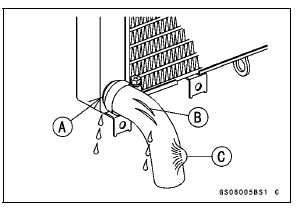

The high pressure inside the radiator hose can cause coolant to leak [A] or the hose to burst if the line is not properly maintained.
Squeeze the hoses. A hose should not be hard and brittle, nor should it be soft or swollen.
Replace the hose if any fraying, cracks [B] or bulges [C] are noticed.
Torque - Water Hose Clamp Screws: 3.0 N·m (0.31 kgf·m, 27 in·lb)

 Coolant Level Inspection
Coolant Level Inspection Engine Top End
Engine Top EndExternal Shift Mechanism Removal
Remove:
Shift Lever (see Shift Pedal Removal)
Oil Pump Drive Gear (see Oil Pump Drive Gear Removal/
Installation in the Engine Lubrication System
chapter)
Circlip [A]
Washer [B]
Special Tool - Outside Circlip Pliers: 57001-144
Remove:
Shift Shaft Assembly [A]
Washer [B] ...
Crankshaft Sensor Peak Voltage Inspection
Refer to the Crankshaft Sensor Peak Voltage Inspection
in the Electrical System chapter.
If the reading is within the standard, remove the ECU and
check the wiring for continuity between harness connectors.
Special Tool - Hand Tester: 57001-1394
Disconnect the ECU and sensor connector ...
Technical Information - Electronic Steering Damper (ESD/ZX1000JD/KD models)
1) Overview
This model has an Electronic Steering Damper (ESD)
[A]. Unlike conventional manual adjustment method of
Kawasaki, damping characteristics are adjusted by the
electronic control unit.
2) Purpose
Designed to offer increased stability at high speed without interfering with
light ...